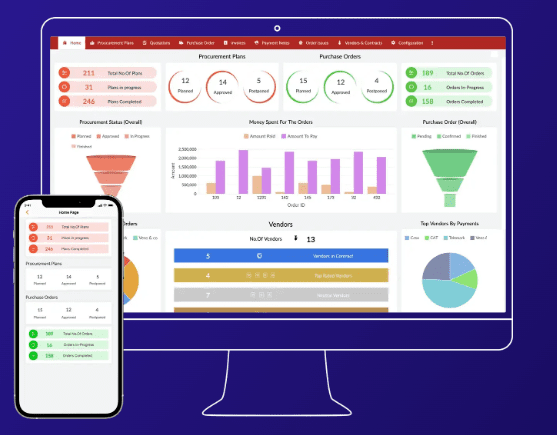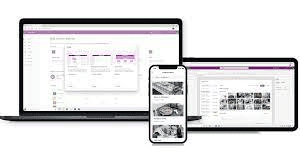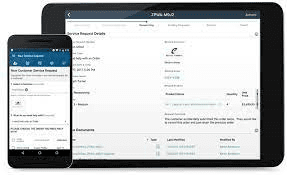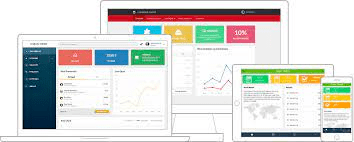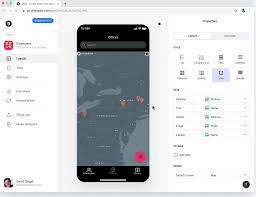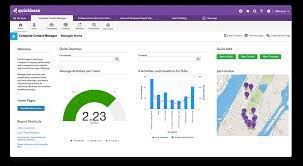What are Low-Code development platforms and How do They Help?
Low-code is a way of development that enables individuals and businesses to create unique applications and automate activities without much coding knowledge. These solutions frequently leverage a drag-and-drop interface and pre-built templates, making it simple for non-technical users to create and customize applications. Low-code solutions are gaining appeal among businesses attempting to streamline operations, increase efficiency, and respond quickly to shifting business requirements. Popular low-code systems include Zoho Creator, Salesforce Lightning, PowerApps, Appian, Mendix, OutSystems, Bubble, and QuickBase. Comparing low-code platforms can help firms decide how to enhance operations, increase efficiency, and save time.
Various industries utilize low-code platforms, including healthcare, banking, retail, and manufacturing. Here are some instances of businesses from various industries that are already reaping the benefits of low-code development:
Cerner, Epic Systems, and Allscripts in healthcare
JPMorgan Chase, Wells Fargo, and Capital One are banks.
Retail: Amazon, Walmart, Target
General Electric, Siemens, Honeywell
Government: NASA, Veterans Affairs Department, City of Los Angeles
Insurance: Allstate, Prudential, MetLife
AT&T, Verizon, and T-Mobile are involved in telecommunications.
Pearson and Blackboard are names associated with academic institutions. Coursera
Exelon, Dominion Energy, and NextEra Energy are energy companies. FedEx, UPS, and DHL are transportation companies.
These are a few examples since several businesses in various industries use low-code platforms to enhance their business processes and operations.

Comparing and contrasting eight of the best low-code development platforms and their use cases
Comparing and contrasting eight of the best low-code development platforms and their use cases
Low-code platforms are transforming the creation and deployment of software by businesses. By providing a user-friendly interface, these solutions enable businesses to optimize procedures, automate tasks, and boost productivity without requiring substantial technical expertise.
With the capacity to build custom apps and automate processes using pre-built templates and drag-and-drop interfaces, low-code platforms are gaining popularity among businesses of all sizes seeking to enhance their operations. Here are eight low-code platform solutions that can help your organization reach its objectives.
Zoho Creator: A low-code development platform enabling the creation of custom apps that automate operations and enhance workflow. The platform is the greatest in terms of low code, user-friendliness, and clarity, making it accessible to users with less or no coding experience.
In addition to job automation and workflow enhancement, Zoho Creator offers data validation, multilingual support, a drag-and-drop interface, and role-based access controls. In addition to ensuring data integrity and security, these capabilities enable enterprises to control who has access to certain information.
Zoho Creator's functionalities range from simple data collection forms to complex business applications. It is a wonderful platform for businesses of all sizes, from startups to global corporations.
Overall, Zoho Creator is a comprehensive and versatile low-code platform that may aid businesses in automating activities, enhancing productivity, and designing custom apps to meet their specific needs.
Salesforce Lightning: A platform for producing bespoke sales and service solutions. It is a component of Salesforce's customer relationship management (CRM) platform meant to improve the user experience, increase productivity, and streamline business operations.
Salesforce Lightning: A platform for producing bespoke sales and service solutions. It is a component of Salesforce's customer relationship management (CRM) platform meant to improve the user experience, increase productivity, and streamline business operations.
Salesforce Lightning's versatility is one of its primary features; it can be used to construct a wide range of customized solutions, including sales automation, customer service management, and marketing automation, among others. It also provides a variety of pre-built templates and components that may be quickly customized to meet your organization's unique requirements.
In addition to its versatility, Salesforce Lightning includes a plethora of capabilities, such as a drag-and-drop interface, connection with other Salesforce products, and a huge assortment of third-party applications and add-ons. These capabilities facilitate the creation and design of apps that automate processes, increase productivity, and streamline operations.
Scalability is another benefit of Salesforce Lightning; it is a robust platform that can expand with your organization and accommodate a huge number of users and data. Additionally, it supports mobile devices, enabling your sales and customer service staff to operate remotely.
Salesforce Lightning is a versatile and adaptable low-code platform that can help businesses develop custom solutions for their sales and support teams, automate operations, increase productivity, streamline procedures, and scale their business.
PowerApps: A platform for developing custom applications and automating processes without coding. It is a component of the Microsoft Power Platform that seeks to empower corporate users to build their own apps, automate operations, and interact with other systems and data.
PowerApps allows users to create custom solutions for various business scenarios, including data collection, approvals, and report generation. It includes data validation, role-based access controls, and support for several languages. In addition to ensuring data integrity and security, these capabilities enable enterprises to control who has access to certain information.
PowerApps is more than just a low-code platform; it's also a powerful tool for process automation, due to Power Automate, a Power Platform component that enables you to automate repetitive tasks and integrate with other apps and services. This can save time, prevent errors, and increase efficiency.
Overall, PowerApps is a strong and flexible low-code platform that may assist businesses in generating bespoke apps and automating operations without the need for coding, as well as boosting productivity, integrating systems and data, and interacting with third-party services. It is a wonderful platform for businesses of all sizes, from startups to global corporations.
Appian is a low-code platform for developing custom applications and automating operations. Appian's drag-and-drop interface is one of its primary advantages, allowing users to design and personalize their own applications effortlessly. The platform also includes pre-built templates, connectors, and system integration, making it simple to construct and customize applications to meet unique business needs.
Appian delivers process modeling, data validation, and role-based access limitations in addition to process automation and workflow optimization. In addition to ensuring data integrity and security, these capabilities enable enterprises to control who has access to certain information.
The possibilities of Appian range from simple data collection forms to complex enterprise-level applications. It is a wonderful platform for businesses of all sizes, from startups to global corporations.
Appian possesses extensive BPM (Business Process Management) features, enabling businesses to model, automate, and improve their operations. This can help businesses increase operational efficiency, save expenses, and boost customer satisfaction.
Overall, Appian is a comprehensive and versatile low-code platform that may assist organizations in automating operations, enhancing workflow, generating custom-tailored apps, and optimizing their business processes.
Mendix is a platform for developing custom apps that automate operations and enhance workflow. Mendix's Model-Driven Development (MDD) approach, which allows users to develop and change applications using a visual modeling environment, is one of its primary characteristics. This technique makes it simple for non-technical users to comprehend and interact with the applications' underlying logic and data. It also includes pre-built templates and connectors, making it simple to design and configure applications to meet unique business requirements.
OutSystems: A platform for developing custom applications and automating processes without coding. It is user-friendly and simple, making it suitable for those with little to no coding knowledge.
One of OutSystems' key advantages is its visual development environment, which allows users to design and customize applications via a drag-and-drop interface. The platform also contains pre-built templates and connectors that simplify the construction and configuration of applications to satisfy specific business needs.
In addition to automating procedures and enhancing efficiency, OutSystems delivers features such as data validation, role-based access limitations, and multilingual support. In addition to ensuring data integrity and security, these capabilities enable enterprises to control who has access to certain information.
OutSystems' capabilities range from straightforward data collection forms to complex enterprise-level solutions. It is a wonderful platform for businesses of all sizes, from startups to global corporations.
OutSystems also offers a comprehensive suite of mobile app development capabilities, enabling organizations to create and deploy mobile apps compatible with iOS and Android handsets. In addition, it offers a rich set of integrations with other systems, such as Salesforce, SAP, and Oracle, as well as numerous programming languages, such as Java and.NET.
OutSystems is a strong and flexible low-code platform that may aid businesses in automating operations, enhancing workflow, developing custom applications tailored to their specific needs, delivering mobile applications, and rapidly integrating with other systems.
Bubble: A platform for developing unique applications without the need for coding. One of its standout features is bubble's visual development environment, which allows users to construct and configure applications using a drag-and-drop interface. The platform also includes pre-built templates and the ability to link to APIs, making it simple to construct and configure applications to meet the needs of unique businesses.
Bubble enables businesses to create a variety of customized solutions, including e-commerce sites, marketplaces, and social networks. It includes data validation, role-based access controls, and support for several languages. In addition to ensuring data integrity and security, these capabilities enable enterprises to control who has access to certain information.
Bubble also offers a powerful collection of tools for online and mobile app development, enabling businesses to create responsive web applications that function on any platform and to launch mobile apps that are compatible with iOS and Android devices. In addition, it provides a variety of interfaces with other systems, such as Stripe, PayPal, and Mailchimp, and can connect to any REST API.
Overall, Bubble is a powerful and flexible low-code platform that may aid enterprises in developing unique apps without coding, enhancing workflow, and integrating systems. It is a wonderful platform for businesses of all sizes, from startups to global corporations.
QuickBase: A platform for developing custom applications and automating processes without coding. QuickBase's visual development environment, which allows users to design and customize applications using a drag-and-drop interface, is one of its primary features. The platform also includes pre-built templates and connectors that make it simple to construct and configure applications to meet unique business requirements.
In addition to automating operations and enhancing workflow, QuickBase delivers features like data validation, role-based access limitations, and multilingual support. In addition to ensuring data integrity and security, these capabilities enable enterprises to control who has access to certain information.
QuickBase's functionalities range from simple data collection forms to complex business applications. It is a wonderful platform for businesses of all sizes, from startups to global corporations.
QuickBase features significant integration capabilities with other systems such Salesforce, Google Apps, and Microsoft Office, as well as programming languages including Java, C#, and Python. Businesses can now utilize existing systems and data while interacting with other services and applications without difficulty.
QuickBase is a comprehensive and versatile low-code platform that may aid businesses in generating innovative applications and automating processes without the need for coding. It may improve workflow, streamline processes, and integrate with other systems and data.
These low-code solutions provide a variety of features and capabilities, ranging from custom application development to task automation. You can improve workflow, streamline procedures, and increase efficiency by enabling your organization with these solutions.
How to Choose the Right Low-Code Solution for Your Business
Choosing the best low-code solution for your company can be difficult, but choosing one that suits your specific goals and expectations is critical. The first step in selecting a low-code solution is to describe your business goals and identify the operations that need to be automated. Once you've determined your requirements, you may look at different low-code solutions and compare their features and capabilities. It's critical to find a platform that's user-friendly and simple to understand, as well as one with a diverse set of pre-built templates and connectors with other applications. You should also assess the solution's scalability and the level of support and resources available. Before making a final selection, trying out a free trial or demo version of a low-code solution is a good idea. It's also a good idea to solicit input from your team members, who will utilize the platform daily. Your company may enhance workflow, increase efficiency, and adapt swiftly to changing business needs by implementing the correct low-code solution.
In summary;
Step 1: Describe your business objectives and determine which processes must be automated.
Step 2: Research various low-code solutions and compare their capabilities and features.
Step 3: Search for a user-friendly and straightforward platform.
Step 4: Check for various pre-built templates and connectors with other apps.
Step 5: Assess the solution's scalability and the level of accessible support and resources.
Step 6: Try a free trial or demo version of the low-code solution.
Step 7: Solicit feedback from team members who will daily use the platform
Step 8: Make a final decision based on the solution that best meets your specific objectives and requirements.
Understanding How Low-Code Solutions Help Streamline Your Business Processes
- Understanding How Low-Code Solutions Help Streamline Your Business Processes
Low-code solutions are intended to help streamline company processes by providing an easy-to-use interface via which users may construct custom applications and automate functions without requiring considerable coding skills. These solutions often employ a drag-and-drop interface and pre-built templates, allowing non-technical people to construct and customize applications easily. Low-code solutions can help businesses improve workflow and productivity by automating repetitive or time-consuming processes. They also enable businesses to respond swiftly to changing needs by allowing them to develop, test, and deploy new applications in hours or days rather than weeks or months. Furthermore, because they enable business users to design and operate their own applications, low-code solutions can help to minimize IT burdens. As a result, operations are more streamlined, productivity is higher, and the company is more nimble.
In summary;
Low-code solutions give a user-friendly interface for developing custom apps and automating operations without requiring substantial coding knowledge.
Non-technical users are able to construct and modify apps using a drag-and-drop interface and pre-built templates.
Low-code solutions enhance workflow and productivity by automating tedious or repeated operations.
Enables rapid reaction to changing needs by facilitating rapid application development, testing, and deployment.
Low-code solutions enable business users to create and manage their own applications, thereby relieving IT of its responsibilities.
Streamlines operations, boost productivity and makes the business more agile.
With fewer resources and time, low-code solutions may help organizations of all sizes increase their operations and productivity.
Low-code solutions can facilitate integration with other systems, data, and services for enterprises.
Low-code solutions can help firms create mobile apps compatible with iOS and Android.
A Look into the Benefits of Using a Low Code Platform for Your Organization
- A Look into the Benefits of Using a Low Code Platform for Your Organization
Low-code platforms provide numerous advantages to enterprises wishing to streamline their processes and increase efficiency. One of the primary advantages is the ability to design unique applications without substantial coding experience. This enables non-technical people to design and customize apps, saving time and resources.
Furthermore, low-code platforms enable speedier development and deployment of new applications, allowing enterprises to respond swiftly to changing business needs.
They also enable flexibility and scalability, allowing businesses to adapt and change their procedures as their operations expand readily.
Furthermore, because they enable business users to design and operate their own applications, low-code platforms can help to minimize IT burdens.
They are also more cost effective than traditional development approaches because they involve less development time and resources. Low-code platforms can help firms enhance their workflow, increase productivity, and respond rapidly to changing business needs.
In summary;
Capability to develop unique applications without substantial coding skills Enables non-technical individuals to design and modify programs.
Saves time and materials
Rapider creation and deployment of new applications
Enables rapid responsiveness to fluctuate business needs
Provides the adaptability and scalability to adjust and adapt procedures as operations grow
Reduces IT burdens by empowering business users to create and operate their own apps.
More economical than conventional development methods
Involves less development time and resources
Enhances process and boosts efficiency
Allows for a quicker reaction to fluctuating business needs.
Is low-code platform the future?
- Is low-code platform the future?

Imagine a future where software customization and process automation are as simple as dragging and dropping. Without committing costly and time-consuming development costs, businesses of all sizes can streamline their processes and increase productivity. Entrepreneurs may readily implement their ideas, and small businesses can compete on an equal footing with multinational organizations. Consequently, innovation occurs rapidly, and organizations are able to respond to the ever-changing demands of the market.
With this kind of low-code platform, the future is bright. Companies can focus on their core competencies while the low-code platform handles the technical parts of app development and deployment. IT departments are no longer burdened with development tasks, allowing them to focus on strategic goals. The IT-business cooperation is stronger than ever since business users may create their own apps and IT can ensure the platform's security, scalability, and governance.
As the need for low-code platforms increases, the technology will evolve to become more robust and intuitive. Companies may create more advanced applications, automate more intricate processes, and integrate more systems and data. The low-code platform will become an indispensable tool for businesses of all sizes and will be the key to the digital transformation of every organization.
In the future, low-code platforms will define how firms deliver new processes and services. Soon, organizations will be able to create and implement new processes and services within minutes. This will enable them to respond swiftly to shifting market conditions and customer demands.
One of the most significant benefits of low-code platforms is that they enable enterprises to develop and deploy new services and processes without requiring extensive IT resources. This will enable businesses to invent and promote new products and services more rapidly. In addition, low-code platforms will allow organizations to customize their processes and services to fit the unique requirements of their customers.
Low-code platforms will also allow businesses to automate several processes, resulting in more effective and simplified operations. In addition to saving time and money, businesses will be able to provide superior customer service. Additionally, automated processes will remove errors and improve data precision, leading in improved decision-making.
Low-code platforms will be leveraged in the future to create and implement innovative distributed and decentralized services and processes. Consequently, organizations will be able to design and implement services and processes closer to their customers, resulting in quicker and more efficient service delivery.
Low-code platforms will determine how businesses deploy new processes and services in the future by enabling them to innovate more quickly, develop and deliver services and processes closer to their customers, and automate a significant portion of their activities. As a result, businesses will be able to respond more quickly to changing market conditions, provide better customer service, and operate more efficiently.
Will AI benefit the low-code development platforms in the future?
Will AI benefit the low-code development platforms in the future?

Low-code platforms driven by AI will also be able to provide enterprises with more personalized and tailored solutions. With artificial intelligence, low-code systems can learn from the data they process and adjust their functionality to the unique requirements of each organization. This will enable firms to develop processes that are more efficient and effective and are adapted to their individual requirements.
Low-code systems driven by AI will also provide enterprises with more sophisticated analytics and reporting capabilities. With AI, low-code systems will be able to give real-time insights and data-driven suggestions to organizations. This will enable companies to make more informed decisions and enhance their overall performance.
In conclusion, incorporating AI technology into low-code platforms will significantly increase their capabilities and give organizations more advanced automation, personalization, and analytics capabilities. This will enable companies to establish more efficient and effective procedures, make better-informed decisions, and enhance their overall performance.
In addition, AI-powered low-code platforms will enable businesses to foresee and anticipate client requirements and market trends. AI's capacity to analyze massive volumes of data enables it to give enterprises useful insights that can streamline their operations and enhance their overall performance. AI-powered low-code platforms will enable enterprises to automate decision-making processes, resulting in enhanced efficiency and precision. In conclusion, incorporating AI technology into low-code platforms will give enterprises a potent weapon that will assist them in staying ahead of the competition and achieving their business objectives more efficiently
Unlock the full potential of Zoho Creator with our comprehensive YouTube tutorials! Visit our website to access a treasure trove of expert-led videos that will take your Zoho Creator skills to the next level. Whether you're a beginner looking to master the basics or an experienced user seeking advanced techniques, our tutorials cover a wide range of topics to cater to all levels of expertise. Join our growing community of Zoho Creator enthusiasts and discover how to build custom applications, automate workflows, and maximize the power of Zoho Creator. Visit our YouTube tutorials page today and embark on a journey of knowledge and innovation!
What are low-code solutions examples?
Low-code solutions examples include platforms like Zoho Creator, OutSystems, Mendix, and Microsoft Power Apps. These platforms provide visual development interfaces that enable users to create applications with minimal coding, accelerating the development process.
How is low-code industry shaping the future of business?
The low-code industry is shaping the future of business by empowering citizen developers and speeding up application development. It allows business users with no coding experience to create applications, enabling faster innovation, increased agility, and improved digital transformation.
What can you build with low-code?
With low-code, you can build a wide range of applications, including customer relationship management (CRM) systems, workflow management tools, project management platforms, employee portals, and more. The flexibility of low-code platforms allows for customization and scalability to meet specific business needs.
What is the future of low-code platform?
The future of low-code platforms looks promising. As businesses continue to embrace digital transformation, low-code will play a vital role in accelerating application development and enabling citizen developers. The platforms will evolve with new features, integrations, and improved user experiences to cater to evolving business requirements.
Which company uses low-code?
Many companies across industries use low-code platforms to streamline their application development processes. Some notable examples include Siemens, Toyota, Deloitte, Lufthansa, and Liberty Mutual. These companies leverage low-code to accelerate innovation, enhance operational efficiency, and improve customer experiences.
What is low-code strategy?
Low-code strategy refers to an organization's approach to utilizing low-code platforms and methodologies. It involves identifying use cases, establishing governance, training citizen developers, and integrating low-code development into the overall digital transformation strategy. A well-defined low-code strategy can drive innovation, agility, and cost savings.

